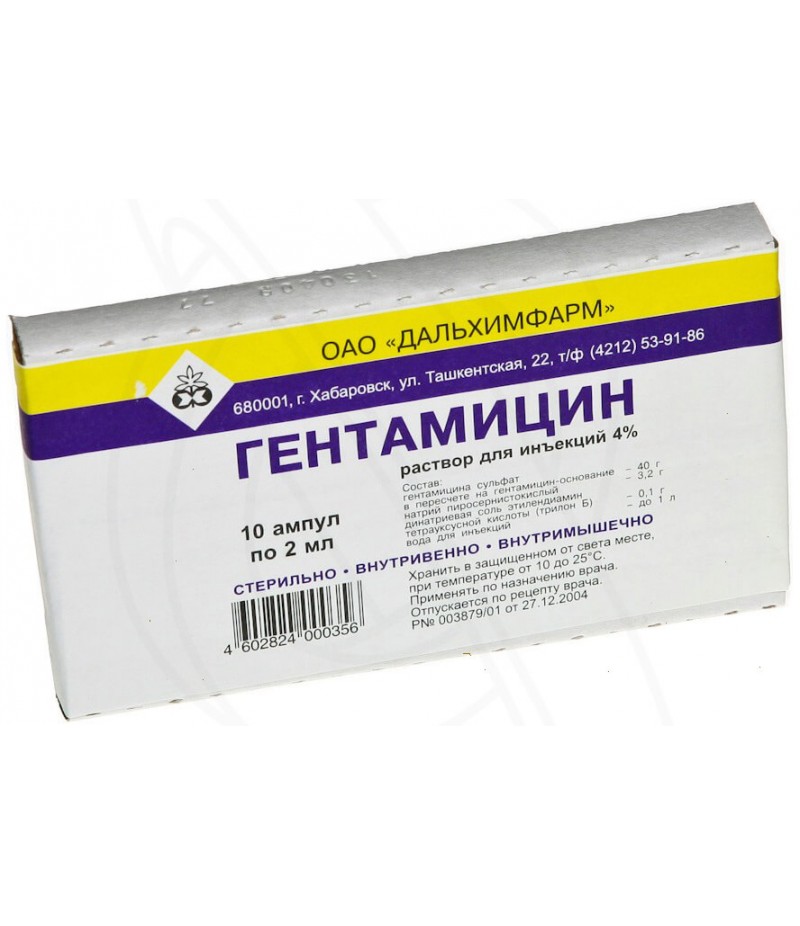Gentamicin-akos ointment 0.1% 15gr
- $4.63
- 3 or more $4.49
- Availability:Out Of Stock
Gentamicin-akos instruction for useYou can buy Gentamicin-akos ointment on this pagepharmachologic effectAntibiotic of a group of aminoglycosides of a wide spectrum of action. Has a bactericidal effect. Actively penetrating throug..
Tags: ointment
Gentamicin-akos instruction for use
You can buy Gentamicin-akos ointment on this page
pharmachologic effect
Antibiotic of a group of aminoglycosides of a wide spectrum of action. Has a bactericidal effect. Actively penetrating through the bacterial cell membrane, irreversibly binds to the 30S subunit of bacterial ribosomes and, thereby, inhibits the synthesis of the protein of the pathogen.
Highly active against aerobic Gram-negative bacteria: Escherichia coli, Shigella spp., Salmonella spp., Enterobacter spp., Klebsiella spp., Serratia spp., Proteus spp., Pseudomonas aeruginosa, Acinetobacter spp.
It is also active against aerobic Gram-positive cocci: Staphylococcus spp. (including those resistant to penicillins and other antibiotics), some strains of Streptococcus spp.
Gentamicin is resistant to Neisseria meningitidis, Treponema pallidum, some strains of Streptococcus spp., Anaerobic bacteria.
Pharmacokinetics
After the / m introduction quickly absorbed from the injection site. Cmax is achieved 30-60 minutes after the / m administration. Binding to plasma proteins is low (0-10%). It is distributed in the extracellular fluid, in all tissues of the body. Penetrates through the placental barrier. It is not metabolized. T1 / 2 2-4 hours 70-95% is excreted in urine, a small amount with bile.
Indications
Infectious-inflammatory diseases caused by microorganisms sensitive to gentamicin.
For parenteral use: acute cholecystitis, cholangitis, pyelonephritis, cystitis, pneumonia, pleural empyema, peritonitis, sepsis, ventriculitis, purulent skin and soft tissue infections, wound infection, burn infection, infections of bones and joints.
For external use: pyoderma (including gangrenous), superficial folliculitis, furunculosis, sycosis, paronychia, infected seborrheic dermatitis, infected acne, secondary bacterial infection in fungal and viral infections of the skin, infected skin wounds of various etiologies (burns, wounds, difficult healing ulcers, insect bites), infected varicose ulcers.
For topical application: blepharitis, blepharoconjunctivitis, dacryocystitis, conjunctivitis, keratitis, keratoconjunctivitis, meibomite.
Contraindications
Hypersensitivity to gentamicin and other antibiotics of the aminoglycoside group, neuritis of the auditory nerve, severe renal dysfunction, uremia, pregnancy, lactation (breastfeeding).
Dosage
Established individually, taking into account the severity of the course and localization of infection, the sensitivity of the pathogen.
With IV or IM introduction for adults, a single dose is 1-1.7 mg / kg, a daily dose of 3-5 mg / kg; the frequency of administration is 2-4 times / day. The course of treatment is 7-10 days. Depending on the etiology of the disease, it is possible to use 120-160 mg once or twice a day for 7-10 days or 240-280 mg once. In / in the infusion is carried out for 1-2 hours.
For children over 2 years of age, the daily dose of gentamicin is 3-5 mg / kg; multiplicity of administration - 3 times / day. Premature and newborn children are prescribed in a daily dose of 2-5 mg / kg; multiplicity of administration - 2 times / day; Children under 2 years of age are prescribed the same dose at a frequency of 3 times / day.
Patients with impaired renal excretory function require a correction of the dosing regimen depending on the values of the CK.
When topical application of gentamicin is instilled in 1-2 drops in the lower conjunctival sac of the affected eye every 1-4 hours.
For external use apply 3-4 times / day.
Maximum daily doses: for adults and children with / in or in / m introduction - 5 mg / kg.
Side effects
From the digestive system: nausea, vomiting, increased activity of hepatic transaminases, hyperbilirubinemia.
On the part of the hematopoiesis system: anemia, leukopenia, granulocytopenia, thrombocytopenia.
From the urinary system: oliguria, proteinuria, microhematuria, renal failure.
From the side of the central nervous system and peripheral nervous system: headache, drowsiness, violation of neuromuscular conduction, hearing loss, vestibular disorders, irreversible deafness.
Allergic reactions: skin rash, itching, urticaria, fever; rarely - angioedema.
Drug Interactions
When used simultaneously with aminoglycosides, vancomycin, cephalosporins, ethacrynic acid, oto- and nephrotoxic action may be enhanced.
With simultaneous use with indomethacin, a decrease in clearance of gentamicin, an increase in its concentration in the blood plasma, while increasing the risk of toxic action.
With simultaneous use with funds for inhalation anesthesia, opioid analgesics increase the risk of developing neuromuscular blockade, up to the development of apnea.
With the simultaneous use of gentamycin and loop diuretics (furosemide, ethacrynic acid), the concentration of gentamicin in the blood increases, which increases the risk of toxic side effects.
special instructions
With caution apply gentamicin in Parkinsonism, myasthenia gravis, renal dysfunction. When gentamycin is used, the functions of the kidneys, auditory and vestibular apparatus should be monitored.
With external application of gentamicin for a long time on large surfaces of the skin, it is necessary to take into account the possibility of resorptive action, especially in patients with chronic renal insufficiency.
Pregnancy and lactemia
Gentamicin is contraindicated in pregnancy. If necessary, use during lactation should stop breastfeeding.
Application in childhood
The application is possible according to the dosing regimen.
In case of violations of kidney function
Contraindicated in severe disorders of kidney function, uremia. With caution in the violation of kidney function. When gentamycin is used, kidney function should be monitored.
Patients with impaired renal excretory function require a correction of the dosing regimen depending on the values of the CK.
In patients with chronic renal insufficiency, it is necessary to take into account the possibility of the resorptive action of gentamicin with its external application for a long time on large skin surfaces.


